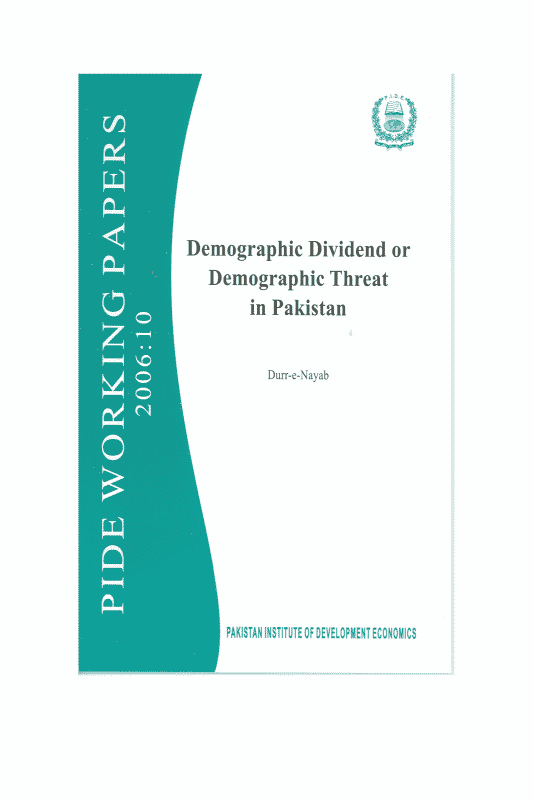
Pakistan Institute of Development Economics
- Home
Our Portals
MenuMenuMenuMenuMenuMenuMenu - ResearchMenuMenuMenuMenuMenuMenuMenu
- Discourse
- The PDR
- Our Researchers
- Academics
- Degree Verification
- Thesis Portal
- Our Portals
Demographic Dividend or Demographic Threat in Pakistan (PIDE Working Papers 2006:10)
ABSTRACT
Population growth and size have remained the focus of debate for centuries but the recent demographic transition in developing countries has made social scientists take note of the changing age structure of the population as well. As a result of declining population growth and consequent changes in age structure, the proportion of working-age population is increasing in most developing countries, with an associated decline in the dependent age population, offering a window of opportunity to these countries that is referred to as the “demographic dividend”.
Pakistan is also going through the demographic transition, and is experiencing a once-in-a-lifetime demographic dividend as the working-age population bulges and the dependency ratio declines. This paper looks into the demographic dividend available to Pakistan and its implications for the country, mainly through three mechanisms: labour supply, savings, and human capital. For economic benefits to materialise, there is a need for policies dealing with education, public health, and those that promote labour market flexibility and provide incentives for investment and savings. On the contrary, if appropriate policies are not formulated, the demographic dividend might in fact be a cost, leading to unemployment and an unbearable strain on education, health, and old age security.
INTRODUCTION
Ever since Malthus gave his apocalyptic views, in the late 18th century, on ever-increasing population and starvation, a debate has persisted over the relation between population growth and economic growth and development. Social scientists, mainly economists and demographers, continue to argue whether population growth encourages, discourages or is independent of economic growth1. The focus of this debate however has mainly remained confined to population size and growth, giving little consideration to the age structure of the population. Bringing age structure dynamics in this debate can be attributed to Coale and Hoover (1958), who argued that sustained high fertility and falling mortality make governments and households burdened with high youth dependency rates, lowering tax revenues and household savings, respectively.
Economists have recently begun to focus on the impact of changing age structure of the population moving beyond the Malthusian emphasis on population growth [Mason (2005); Birdsall, et al. (2001); Sachs (2002); Bloom and Canning (1999); Bloom and Freeman (1986); Lee (2003); Bloom and Sachs (1998); and Bloom and Williamson (1998)]. The interest in relation between population change and economic growth has reignited because of the demographic transition taking place in the developing countries, which are at varying stages in experiencing declining fertility and mortality rates. The life cycle consumption model suggests that different age groups in a population have different economic implications. The young need investment in health and education, adults supply labour, income and savings and at old ages there is a need for retirement income and, again, a requirement to invest in health. As the relative size of each of these age groups change in the population similar is the respective impact of the economic behaviour associated with different ages. This relation is summarised in the lifecycle income and consumption model, a schematic representation of which can be found in Figure I. As a result of declining population growth and consequent changes in age structure, the proportion of working age population is increasing in most developing countries, offering a window of opportunity to these countries, referred to as the ‘demographic dividend’.



